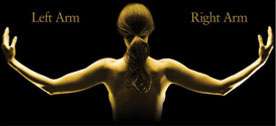Cartilage and Ligament Tears of the Wrist
What are cartilage and ligament tears of the wrist?
The wrist joint is comprised of eight small bones that are arranged in two rows between the forearm bones (radius and ulna) and the hand bones (the metacarpals). The row closest to the forearm is the proximal row and the one closest to the hand is the distal row. The joint between the forearm and proximal row is the radio-carpal joint/ ulno-carpal joint and the joint between the proximal and distal rows is the mid-carpal joint. The three bones in the proximal row that are most susceptible to injury are the scaphoid (S), lunate (L), and triquetrum (T). There are short ligaments, intrinsic, that span between these bones, the scapho-lunate (SL) and the luno-triquetral ligaments (LT). These ligaments are relaxed most of the time allowing some movement between adjacent surfaces and become taut during strenuous activities such as power grasping. Larger ligaments, extrinsic, are at the anterior or palmar aspect of the wrist and span between the radius or ulna and the proximal and distal rows. The triangular fibrocartilage (TFC) is a triangular-shaped cartilage disc that attaches at the edge of the radius bone at the base of the triangle and attaches to the end of the ulna at the apex of the triangle. This provides a sling for the adjacent surfaces of the triquetrum and lunate. Due to specific trauma or repetitive use these structures may become stretched or torn.
What causes cartilage and ligament tears of the wrist?
With significant injuries, the intrinsic and extrinsic ligaments become torn leading to obvious separation of bones on plain radiographs. The most common injuries occur to the intrinsic ligaments with a resulting tear with or without instability (abnormal shifting of bones can cause discomfort and with time traumatic arthritis). This instability usually occurs with stressful activity of the wrist following the original injury. The scapho-lunate ligament injury can result from a fall on an outstretched forward or backward bent wrist or from violently gripping an object. Injuries to the luno-triquetral ligament tend to occur from a fall on an outstretched wrist with a force directed toward the palmar ulnar aspect of the wrist or from forceful forearm rotation. The TFC injuries usually occur from torquing injuries or a fall on an outstretched wrist.
What are the symptoms of cartilage and ligament tears of the wrist?
- Usually localized pain if isolated ligament tear
- Limited motion
- Swelling
- Painful popping/ clicking
- Weakness
- Aggravated with increased activity
- History of trauma usually with sudden onset/ can occur insidiously after repetitive work
How to diagnose cartilage and ligament tears of the wrist:
In addition to a careful history of the symptoms described above, an examination will reveal:
- Discrete tenderness at back or dorsum of wrist at area of ligament tear or TFC
- Swelling: localized or diffused
- Painful motion
- Limited motion
- Palpable click/grinding
- Weakness of grip
- Watson: S-L instability
- Shuck: L-T instability
Additional tests may be helpful:
Radiographs (routine PA, LAT, OBL views of wrist):
normal in most ligament injuries; may show widening at S-L interval or abnormal S-L angle
MRI-arthrogram:
Reveals an accurate diagnosis in approximately 60% of cases
CT scan:
Useful if occult fracture suspected
Selective injection:
can be beneficial if xylocaine removes source of pain temporarily, xylocaine mixed with contrast on the arthrogram may also give same information
Non-surgical treatment of cartilage and ligament tears of the wrist:
It is reasonable to treat cartilage tears with a splint and NSAID’s (Advil,Aleve, etc.) for 4 weeks to see if symptoms improve. It is not uncommon to have symptoms improve and then worsen ultimately requiring surgery. Similarly ligament tears may be partial and improve or resolve with initial splinting assuming there is no evidence of scapholunate widening.
Surgical treatment of cartilage and ligament tears of the wrist:
S-L ligament tear/ L-T tear:
If duration is greater than one month I would recommend arthroscopic debridement (and pinning with multiple pins if instability is present with ~85-90% success rate when performed within 3 months of the time of injury; this rate falls to ~60% at one year); if acute injury, with significant instability (static, as viewed on plain radiographs with widening of S-L interval, or DISI position of lunate then would consider open repair); if arthroscopic surgery is not successful or patient presents with significant long-term instability then would recommend limited wrist arthrodesis (fusing of several bones together which can cause significant loss of movement); chronic L-T instability: L-T arthrodesis, chronic L-T instability with VISI: L-T-C-H arthrodesis, chronic S-L instability: STT arthrodesis, S-L instability with SLAC: SLAC arthrodesis, chronic perilunate(S-L and L-T) instability: SLAC.
TFC tear:
central or radially (most common), debridement; peripheral margin, repair.
After surgery: (link wrist arthroscopy landing page with you tube video and link to article)
Arthroscopic debridement only:
Splint until sutures removed at 8-10 days then aggressive therapy for 4-6 weeks; if arthroscopic TFC repair: immobilize in long arm cast or splint for 6 weeks followed by 6-8 weeks of therapy
Arthroscopic debridement and pinning:
Remove pins at 8 weeks(left under skin); then protective splint with active motion for 4 weeks in therapy, then d/c splint and passive motion for 4 more weeks, then strengthening exercises for an additional 4 weeks.
How can Dr. Knight help you with cartilage and ligament tears?
Dr. Knight is one of the leading specialists in his field in the treatment of wrist injuries and disorders. He has significant experience in making the difficult diagnosis of a cartilage and ligament tear and has a high success rate with minimally invasive stitchless advanced wrist arthroscopy in returning the elite athlete to their sport (link Natu testimonial and you tube video)
Disclaimer
HandAndWristInstitute.com does not offer medical advice. The information presented here is offered for informational purposes only. Read Disclaimer

